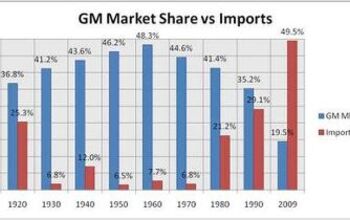Editorial: The Truth About GM's IPO
One might believe that GM’s forthcoming IPO marks the second coming of Christ. GM, once the world’s largest corporation, faced oblivion in the winter of 2009. The train wreck of this former company reemerged from burial last summer through the generosity of the US and Canadian taxpayer as a new company shorn of most of its former financial liabilities, unproductive assets, and brands it no longer could support. Everything that Jerry York (R.I.P.) told the automotive world in January 2006 that GM needed to do to survive back then finally came to pass. And now, it’s preparing an IPO to swap ownership from the governments to the public. Ed Whitacre and his team will get the credit for a most remarkable turnaround while Obama will bask in the light of his stewardship of public monies. Let’s get the story straight.
For starters, GM’s “turnaround” is mostly a result of the balance sheet restructuring. By eliminating its onerous debt load, transferring a good portion of its UAW VEBA obligation from debt to equity, and killing four brands along with eliminating a bunch of unnecessary assets (like NUMMI), it greatly lowered its operating breakeven level in North America. Think of it as you tearing up your credit cards, getting rid of most of your mortgage and auto loans, and stop alimony payments to your two ex-wives. You could cut your salary in half and survive. It has nothing to do with the genius of Ed Whitacre.
Instead, GM launches a whole bunch of new products, all of which were designed and engineered as part of the old GM, that just happen to be pretty darn good (thanks to Bob Lutz and Ed Welburn). Think Camaro, new Equinox, new SRX, and new Lacrosse, and maybe even the upcoming Cruze. On top of that, GM has a potential technological “tour de force” in the new Volt that could possibly anoint GM as the “King of Green.” Oh yeah, GM comes out of bankruptcy during one of the deepest recession in automotive sales in history (relative to the trend line) and start selling again into an upswing. Then its major competitor, Toyota, stubs its entire foot by ignoring a major design flaw that results in death and dismemberment of several US citizens including a California highway patrolman and family.
Even so, GM’s market share remains flatlined mostly at around 18%. But it’s enough share (and volume) that it pays back $6.7 billion of government debt through an escrow fund set up for extraordinary expenses that was barely tapped – and that’s only because the terms of that extra funding required it to be applied against the debt if it wasn’t used for emergencies. Whitacre goes on TV and dupes the public without revealing the true nature of the repayment. That’s like using the estate money you inherited – which was never your money in the first place – to pay off your bookie… but you tell your third wife she can keep her diamond ring and now she thinks you’re her hero.
GM reports its first quarter earnings and, surprise, it makes money in North America for the first time in years. And it even manages to reduce losses in Europe while its China JV’s hum along nicely as before. The future looks bright – time to put on the shades. It’s so bright that the GM top executives look to reward themselves some $13 million in restricted stock for just being in the right place at the right time – and by coasting off of new products designed before some of them even knew they’d be in Detroit.
But what’s really driving the IPO is not the requirement to raise capital for GM. Instead, it’s a combination of factors, mostly the need for the Obama Administration to win political points before the November elections. A market value on the Treasury holdings – most of which it will still own even after the IPO – will make headlines all by itself and prove to the taxpayers that the Government Motors moniker is no more. Second, Wall Street investment banks see huge fees of the IPO and secondary offerings of what will be one of the larger stock issuances of all times. Third, Ed Whitacre (and other insiders) wants to proclaim victory and put a value on shareholdings.
What about that value? Here’s what the Congressional TARP Oversight Panel has to say on the topic:
The valuation of New GM used by the bankruptcy court estimated that the market capitalization (the price of all outstanding shares) of the new entity would be worth between $59 and $77 billion in 2012. Treasury has invested a combined $49.5 billion in the New and Old GM and approximately 61 percent of equity in New GM.280 Assuming full repayment of the $8.8 billion note and preferred stock issued by New GM to Treasury, the shares in New GM will have to be worth $40.7 billion (the difference between $49.5 billion and $8.8 billion) for Treasury‟s investment to be repaid when Treasury sells its shares, meaning the market capitalization of the entire company needs to be worth $67.7 billion. In April 2000, when Old GM shares were at the height of their value (not adjusted for inflation), the company‟s total value was only $57.2 billion. In other words, New GM will have to achieve a capitalization that is higher than was ever achieved by Old GM if taxpayers are to break even.
GM is still in turnaround mode. Yes, it will pull off an IPO – likely by early in the fourth quarter this year – and will garner accolades from Obama, Wall Street, and even some competitors for its remarkable story. But GM still faces a massive problem in Europe – Opel/Vauxhall has been a perennial laggard in a market that now looks to be moribund for years. The new executive team hasn’t yet sold a car that it has designed and developed for North America. And we’re still trying to decipher the playbook of the four brands in North America. The IPO is merely a swap of stakeholders in the company – from the government to the public – but there’s still little there to tell us whether or not GM in the future will be a winner. Place your bets!
More by Ken Elias
Latest Car Reviews
Read moreLatest Product Reviews
Read moreRecent Comments
- Calrson Fan Jeff - Agree with what you said. I think currently an EV pick-up could work in a commercial/fleet application. As someone on this site stated, w/current tech. battery vehicles just do not scale well. EBFlex - No one wanted to hate the Cyber Truck more than me but I can't ignore all the new technology and innovative thinking that went into it. There is a lot I like about it. GM, Ford & Ram should incorporate some it's design cues into their ICE trucks.
- Michael S6 Very confusing if the move is permanent or temporary.
- Jrhurren Worked in Detroit 18 years, live 20 minutes away. Ren Cen is a gem, but a very terrible design inside. I’m surprised GM stuck it out as long as they did there.
- Carson D I thought that this was going to be a comparison of BFGoodrich's different truck tires.
- Tassos Jong-iL North Korea is saving pokemon cards and amibos to buy GM in 10 years, we hope.


































Comments
Join the conversation
"For starters, GM’s “turnaround” is mostly a result of the balance sheet restructuring. By eliminating its onerous debt load, transferring a good portion of its UAW VEBA obligation from debt to equity, and killing four brands along with eliminating a bunch of unnecessary assets (like NUMMI), it greatly lowered its operating breakeven level in North America." That is the whole point of bankruptcy restructurings, to eliminate enough debt that the surviving organization has a chance to succeed while replacing that debt with equity so that the debt holders have a chance of recovering something. As to the argument that the new management is simply reaping the product benefits of the old team, what about the designers and engineers who actually did the day to day development work on those new models? Most of them would be on unemployment right now were it not for the government's intervention. Now, what I want to know is how Iraq and Afghanistan are going to repay the trillion plus dollars and thousands of lives poured down those rat holes.
“Taxes are for the purpose of protecting individual rights.” Nonsense, pure and simple. Mr. Horner, Doc was absolutely right about that first line, and you're absolutely wrong with the second. Read the Declaration of Independence: "...We hold these truths to be self evident, that all men are created equal, that they are endowed by their Creator with certain unalienable rights... that to secure these rights, governments are instituted among men..." There's an old saying, "France is a Land, Britain is a People, America is an Idea." The words in the Declaration above express the American Idea. Commenters here from other countries don't have to believe it, but any American who doesn't believe it is ignorant of his own country. The American Idea is on-topic in any discussion of American government involvement with the auto industry, or any industry. Americans may not explicitly remember the lesson from civics classes, but the widely felt unease with bailouts of all types indicates the American public has absorbed the lesson, and still views its government as limited in nature and purpose. Mr. Horner, if you're not an American, please refrain from attacking the fundamental underpinnings of the American state. If you ARE an American, pick up an American history book and READ it.